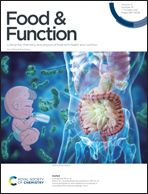The protective mechanism of a debranched corn starch/konjac glucomannan composite against dyslipidemia and gut microbiota in high-fat-diet induced type 2 diabetes†
Abstract
This study aimed to explore the protection mechanism of a debranched corn starch/konjac glucomannan (DCSK) composite against type 2 diabetes (T2D) related to dyslipidemia and gut microbiota in mice fed on a high-fat diet (HFD). The results showed that the consumption of DCSK led to a significant improvement in the biochemical parameters and physiological indices associated with T2D in the HFD group, including the decrease in blood glucose, triglyceride, total cholesterol, and high-density lipoprotein cholesterol levels, as well as the suppression of the oxidative stress of the liver and kidneys. Furthermore, the health of the intestinal microbiota in the HFD-fed mice was altered dramatically after DCSK consumption. Metabolomics revealed 13 differential metabolites strongly linked to DCSK intervention, and DCSK supplementation regulated amino acid metabolism, nucleotide metabolism, and lipid metabolism. These findings demonstrated that DCSK has an outstanding ability to improve hyperglycemia, hyperlipidemia, and gut microbiota associated with T2D.



 Please wait while we load your content...
Please wait while we load your content...